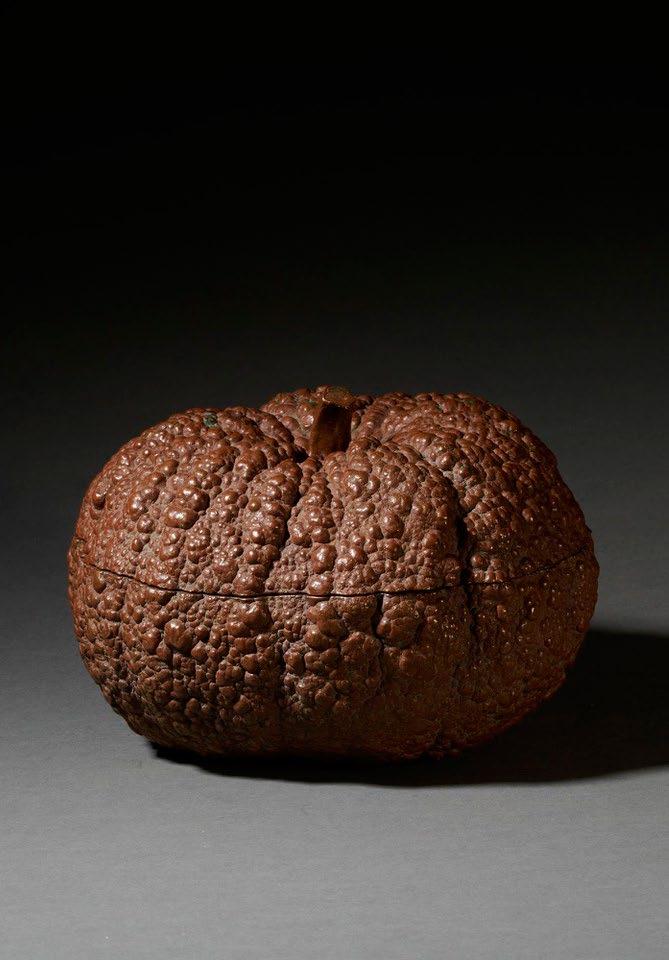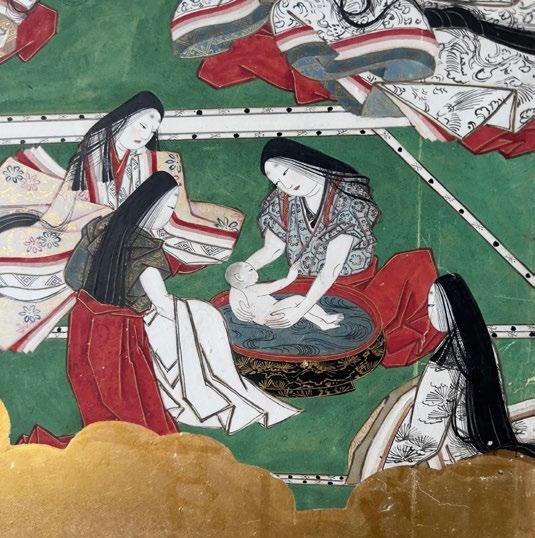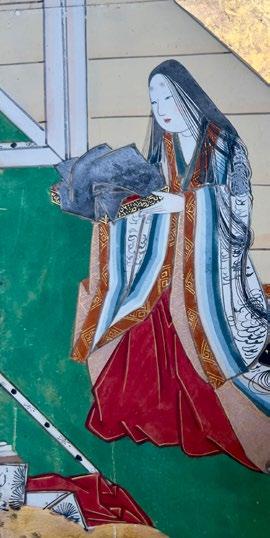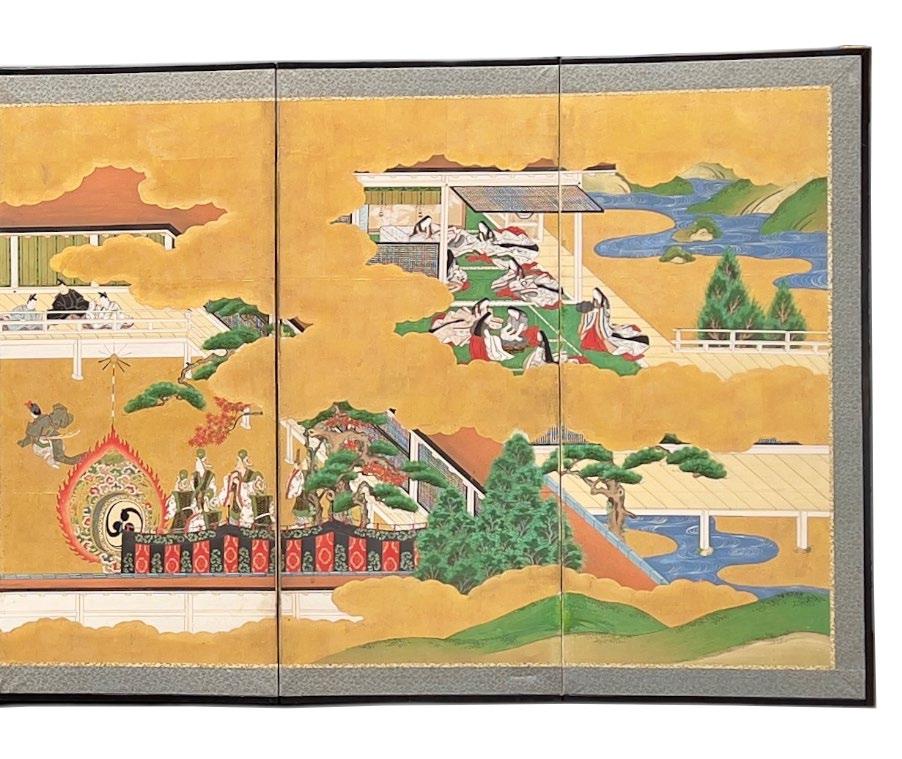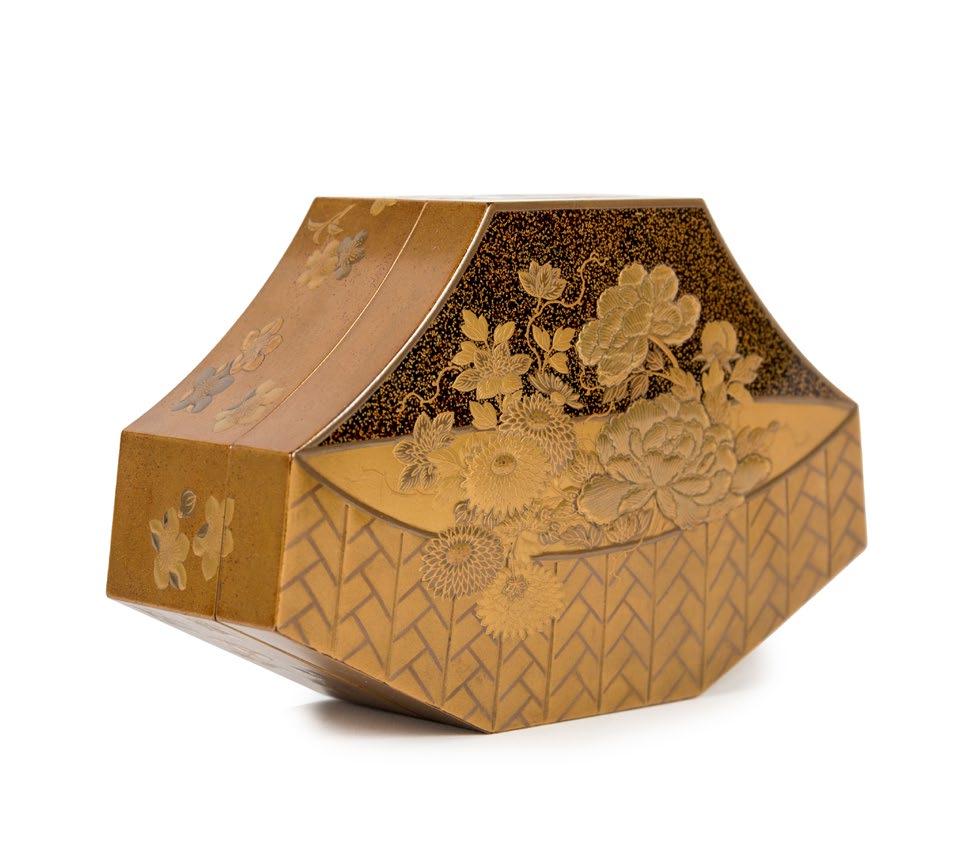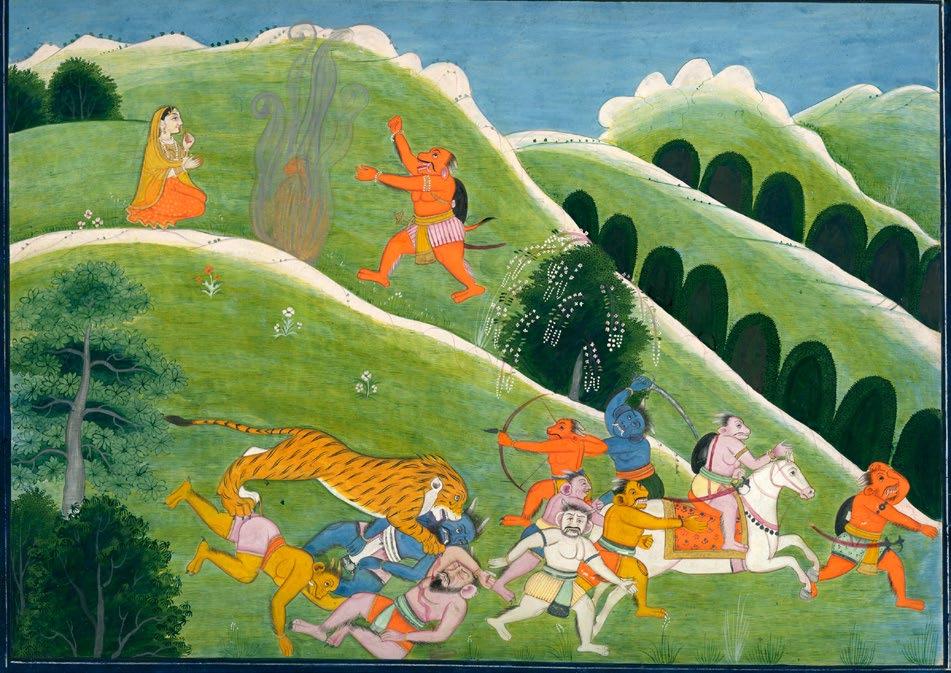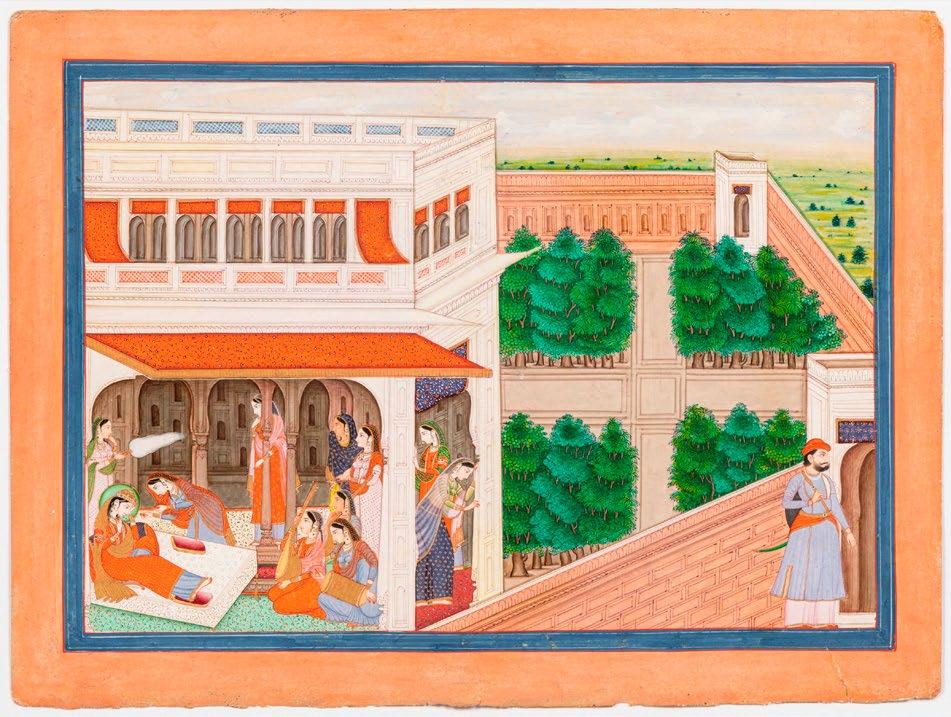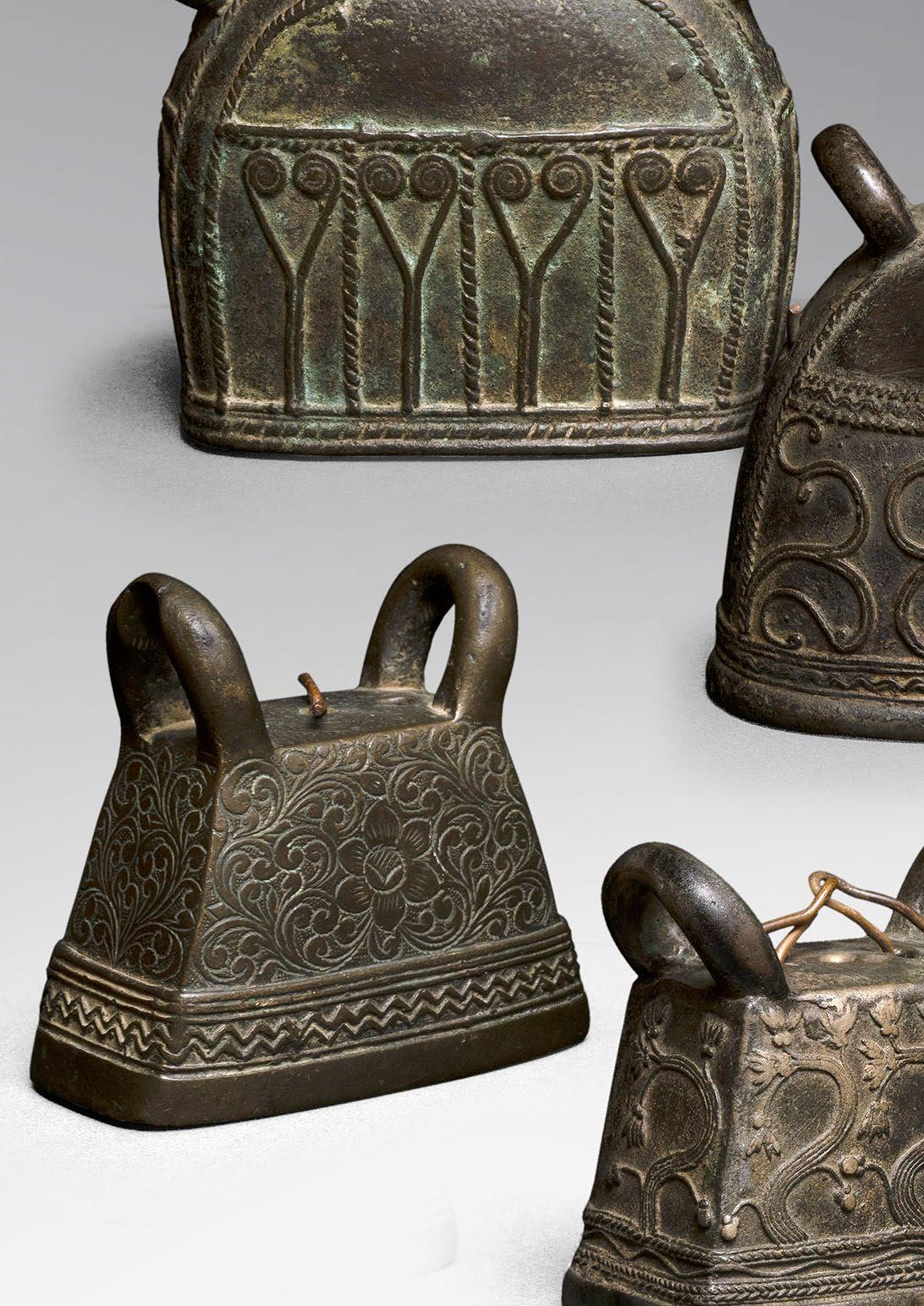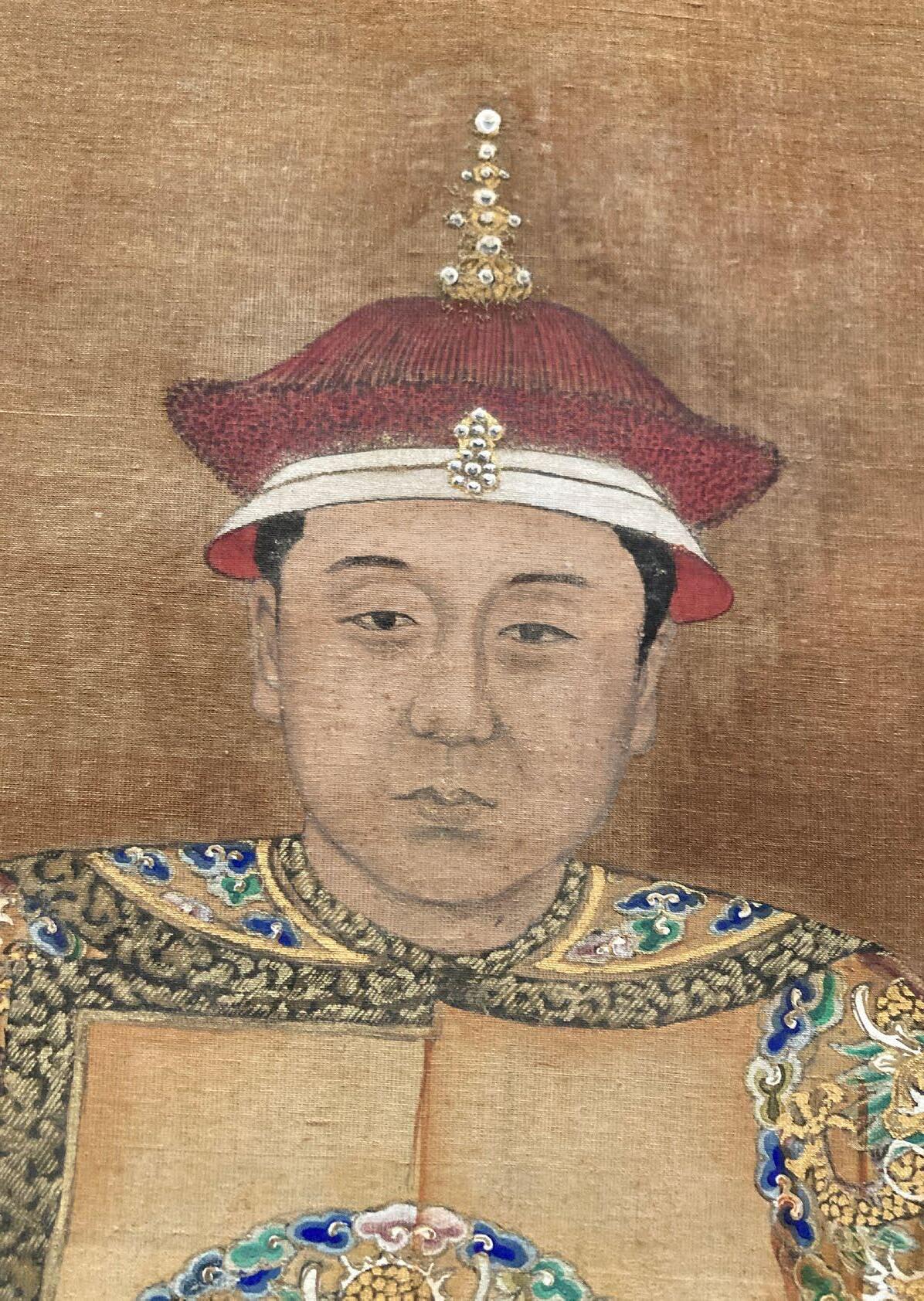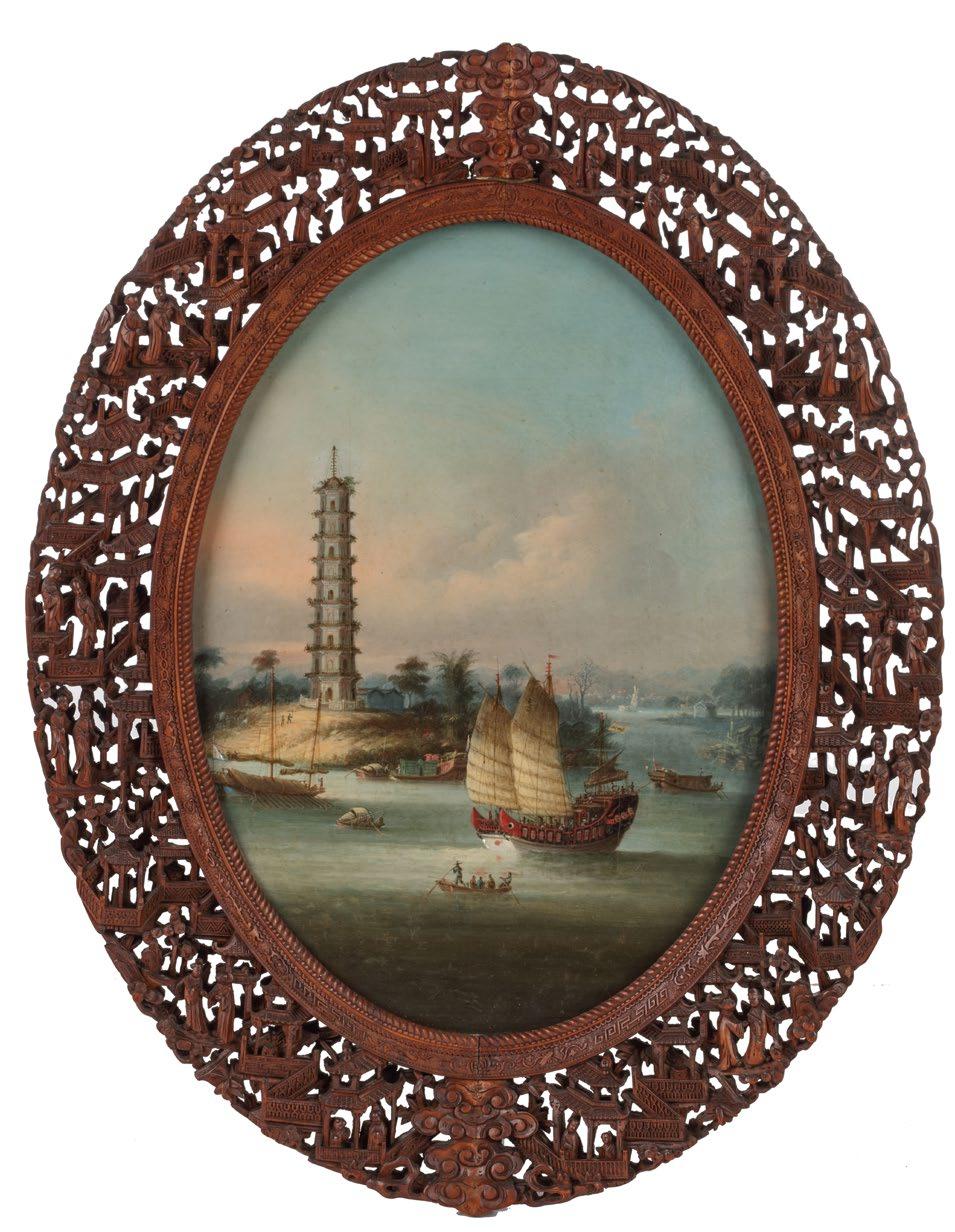JUly ARTWORK s
Pieces are published and changed each month. The objects are presented with a full description and corresponding dealers contact information Unlike auction sites or other platforms, we empower collectors to interact directly with the member dealers for enquiries and purchases by clicking on the e-mail adress.
In order to guarantee the quality of pieces available in the catalogues, objects are systematically validated by all our select members, who are the in-house experts. Collectors are therefore encouraged to decide and buy with complete confidence. In addition to this the Asian Art Society proposes a seven-day full money back return policy should the buyer not feel totally satisfied with a purchase. Items are presented by categories please check the table of contents.
Feel free to ask the price if the artwork is listed with a price on request.
B RON ze Fl OW e R VA se
Signed by Masatomo
Japan
Meiji period
A very fine bronze flower vase, delicately cast with a group of flowering narcissi
Height: 30,5 cm
Price on request
Obj EC t Pr ESE nt E d by:
Brandt Asian Art
M.: +44 (0)7774 989 661
E.: brandt@nildram.co.uk
W.: www.brandtasianart.com
Signed by Morimitsu
Japan
Meiji Period
A heavily cast bronze vase case with a fine quality crayfish and clams, with an overall rich green patina
Height: 37 cm
Price on request
Obj EC t Pr ESE nt E d by:
Brandt Asian Art
M.: +44 (0)7774 989 661
E.: brandt@nildram.co.uk
W.: www.brandtasianart.com
C RAy F is H VA se
P U m PK i N B Ox
Japan
Circa 19th century
A curious copper box in the form of a pumpkin, the exterior body realistically cast, and the interior in red lacquer
Depth: 22 cm
Price on request
Obj EC t Pr ESE nt E d by:
Brandt Asian Art
M.: +44 (0)7774 989 661
E.: brandt@nildram.co.uk
W.: www.brandtasianart.com
T H e TA le OF Ge NJ i
Folding Screen
Japan
Edo period
Early 19th century
Painting on paper, mineral pigments and gold leaf, mounted on a sixpanel screen. Borders of silk brocade and lacquered wood, with engraved brass protective fittings 106 cm x 362 cm
Price: 9.500 euros
Obj EC t Pr ESE nt E d by: Cristina Ortega & Michel Dermigny www.cristinaortega.com
E.: info@cristinaortega.com
T.: + 33 (0)1 42 61 09 57 + 33 (0)6 07 48 10 28
This folding screen from the Edo period, dating to the early 19th century, depicts several scenes from The Tale of Genji, a major literary work written by Lady Murasaki in the early 11th century. This novel, often considered the first novel in history, narrates the life and loves of Hikaru Genji, a prince of the imperial court.
The central part of this screen is particularly remarkable. It illustrates Chapter 24 of The Tale of Genji, in which court maidens, dressed as butterflies and kalavinka birds, dance beneath cherry blossoms. The beauty of this scene is striking, showing both court figures as well as dancers and musicians. The kalavinka, a mythical bird whose melodious song is considered the voice of the Buddha, adds a spiritual dimension to this representation.
The event described in this chapter is an official ceremony of reading Buddhist sutras, sponsored by the Empress. This ceremony, reflecting the piety and support of the imperial court towards Buddhism, highlights the importance of religious rituals in the aristocratic society of the Heian period (7941185). Buddhist rituals were often integrated into court festivities, symbolizing both religious devotion and cultural refinement.
The other scenes depict more intimate moments, such as the one on the right where women are busy washing a child in a lacquered basin.
Historically, the Edo period (1603-1868) was marked by relative peace and economic prosperity, which allowed for a flourishing of the arts. Folding screens like this one are typical examples of the art of this period, combining aesthetic and narrative elements to capture the essence of classic literary works.
A s H i NAGA-T e NAGA
OK im ONO
Japan
Meiji era (1868-1912)
10 cm (h.) x 2,7 cm (l.) x 3 cm (w.)
Price on request
Obj EC t Pr ESE nt E d by: Galerie Tiago
M.: 00 33 1 42 92 09 12 –
00 33 6 60 58 54 78
E.: contact@galerietiago.com
Small sculpture depicting two yokai, monsters or spectres common in japanese folklore, known as Ashinaga-Tenaga, « Long legs – Long arms », holding a fish. They appear for the first time in the Wakan Sansai Zue, an illustrated encyclopedia published in 1712 by Terajima or Terashima (Edo period) and are described as two yokai helping each other to catch fish, one being able to step into the river with the other on his back, the other, also called Chohi would then catch the fish using his long arms.
Their representation can vary, shifting from traits from indian, semitic or african people, however Terajima places them in Japan near the Shakusui river and describes them as Ainus, a people native to Japan. Their association on a netsuke symbolizes the duty we have to help one another.
P e ON y BA s K e T KOBAKO
Japan
Edo period
18th century
4,8 cm (h.) x 15,5 cm (w.) x 9 cm (d.)
Price on request
Obj EC t Pr ESE nt E d by:
Galerie Tiago
T.: 00 33 1 42 92 09 12
M.:00 33 6 60 58 54 78
E.: contact@galerietiago.com
Eight-sided, flared shaped lacquer kobako box, following the decoration on the lid depicting a basket of flowers, composed of peonies and chrysanthemums in gold takamaki-e and hiramaki-e lacquer on a nashi-ji background. The edge is decorated with cherry blossoms in gold and silver takamaki-e. Interior and base in nashi-ji.
W AT e RCO l OUR OF mAHARAO R A m s i NGH OF K OTA AN d His sON s H UNT i NG W i TH NU me ROU s R AJA s THAN i i N s CR i PT i ON s
India
Late 18th century - Early 19th century Paper, Watercolour, Pencil
49 cm (h.) x 71 cm (w.)
Provenance:
Private English collection, 1960’s to 2020
Private collection Price on request
Obj EC t Pr ESE nt E d by: Finch & Co www.finch-and-co.co.uk
E.: enquiries@finch-and-co.co.uk
T.: +44 (0)7768 236921
Maharao Ram Singh II of Kota 1827 - 66 is depicted hunting tigers, in the company of a young man who must presumably be his son Maharajkumar Bhim Singh, the future Maharao Shatru Sal II, 1886 - 89. The two are in an ‘odi’ shooting-box, along with three other men who are preparing their guns for them. Five magnificent tigers stride or run through the undergrowth. These are fully drawn and painted, while the other figures and the landscape are sketched in briefly. As always with Kota drawings, one admires the splendid sure line which the tigers and the main trees are sketched in, even though this is a working drawing and ‘pentimento’ is visible.
The presence of Rajkumar Bhim Singh, who looks as he does in a drawing published by Bautze, fig. 2, allows a dating of the painting in the last decade of Ram Singh’s life. Bhim Singh was born 1839 - 40, and his small moustache and growing sideburns indicate an age of at least sixteen.
Finished paintings of Ram Singh hunting tiger are rare, although other drawings do exist: Christie’s, London, 12 June 2018, lot 69, and Philadelphia Museum of Art (Cameron, pl. 20). A drawing of Chattar Sal shooting tiger is in the Mittal Museum in Hyderabad (Topsfield, no. 115).
REFERENCES:
Bautze, J., ‘Portraits of Maharao Shatru Sal of Kota’ in Srivastava, V.S., and Gupta, M.L., eds., Roopankan: Recent Studies in Indian Pictorial Heritage, Jaipur, 1995, pp. 84 - 91 Cameron, A. M., Drawn from Courtly India: The Conley Harris and Howard Truelove collection, Philadelphia and New Haven, 2015 Topsfield, A., and Mittal, J., Rajasthani Drawings in the Jagdish and Kamla Mittal Museum of Indian Art, Hyderabad, 2015
A N i llU s TRAT i ON TO TH e mARKAN deyA
P URANA : Am B i KA
Red UC es TH e d em ON dHU m RA l OCHANA TO As H es
Mandi, India Circa 1825
Gouache heightened with gold on paper
Image: 20 cm x 27,3 cm
Folio: 25,7 cm x 33 cm
Provenance:
Mandi Royal collection, 1969
Private European collection
Price on request
Obj EC t Pr ESE nt E d by:
Kapoor Galleries
T.: + 1 (212) 794-2300
E.: info@kapoors.com
W.: www.kapoors.com
Drawn from the part of the Markandeya Purana called the Devi Mahatmya, this painting depicts the victory of Ambika over Dhumralochana and his army, who were sent by the asura Shumbha. The gods became wary of two demons named Shumbha and Nishumbha, who had undergone great penance to receive a boon that prevents any male, human or not, from killing them. The gods resultantly prayed to the Goddess (Devi) to rid them of these evil creatures, and she came forth from Parvati as Ambika, a form of Devi. Upon learning of this beautiful lady, Shumbha sent Sugriva as a messenger to her with a proposition of marriage.
She replied by telling Sugriva to relay this message to his master Shumbha: “He who conquers me in battle, removes my pride and is my match in strength shall be my husband. So let Shumbha come here then, or Nishumbha the great asura. Vanquishing me here, let him soon take my hand in marriage. Why delay?”
Sugriva retorted by saying: “O Devi, you are haughty. Talk not so before me. Which man in the three worlds will stand before Shumbha and Nishumbha? All the Devas verily cannot stand face to face with even the other asuras in battle. Why mention you, o Devi, a single woman?
Indra and all the other Devas could not stand in battle against Shumbha and other demons, how will you, a woman, face them? On my word itself, you go to Shumbha and Nishumbha. Let it not be that you go to them with your dignity lost by being dragged by your hair.”
Devi said: “Shumbha is strong and so is Nishumbha
exceedingly heroic! What can I do since there stands my ill-considered vow taken long ago? Go back, and tell the Lord of Asuras carefully all this that I have said; let him do whatever he considers proper.” (Chapter 5, verses 120-127).
So Sugriva relayed the message to his master Shumbha, who was outraged at being so disregarded that he sent Dhumralochana and his army to retrieve Amibka by pulling her hair. When Dhumralochana advanced on Ambika, she smote him and he became nothing but a pile of ashes. The demon’s army of 60,000 asuras was likewise vanquished by the lion of Devi, once again instituting the power of the goddess.
i llU s TRAT i ON TO A
R A si KAPR iyA se R ies:
R A d HA s e AT ed W i TH A CONF id ANT i N A PAV ili ON
Attributed to Purkhu Kangra, India
Circa 1820
Opaque watercolor heightened with gold on paper
Image: 27,6 cm x 17,7 cm
Folio: 33 cm x 23,5 cm
Provenance:
Royal Mandi collection
Private English collection Price on request
Obj EC t Pr ESE nt E d by:
Kapoor Galleries
T.: + 1 (212) 794-2300
E.: info@kapoors.com
W.: www.kapoors.com
Seated upon a lush carpet of scrolling florals, Radha listens attentively to her sakhi, one hand resting on a vibrant orange cushion as the other is raised to her chin. Outside, blooming creepers peek out among the foliage where two love birds sit apart among the branches, just as the separated lovers Radha and Krishna. The yoni- and lingam-shaped vessels behind Radha, as well as the tall pointed minaret, are symbolic of desire and longing. A line of black Braj Bhasa above refers to Krishna’s manifested state of heavy separation and Radha’s state of distress caused by quarrels with Krishna. The folio number ‘196’ is inscribed in the upper left corner, the reverse with ‘9ll.’
The verso is inscribed with a verse from the Rasikapriya in alternating red and black script: Sakhi to nayika:
“If you have a complaint against your dear one, you should speak of it only in private to him; it would be wrong to disclose his guilts publicly. If his eyes stray in undesirable directions, you may try to restrain them, but not to prick them with a knife. Remember, he is the same Syama, separation from whom can kindle such a fire in the hearts of women that a solution of camphor will have to be sprayed to cool it.
You should speak as propriety demands, and not speak harshly to one who has abandoned everything for the sake of your love.”
(translation from M.S. Randhawa, Kangra Paintings on Love, New Delhi, 1962, p.90)
i llU s TRAT i ON TO TH e AshtA NAyik A: A BH is AN d H i TA NAyi KA
Kangra, India
Late 19th century
Opaque watercolor heightened with gold on paper
Image: 21 cm x 30,2 cm
Folio: 26,7 cm x 35,9 cm
Price on request
Obj EC t Pr ESE nt E d by:
Kapoor Galleries
T.: + 1 (212) 794-2300
E.: info@kapoors.com
W.: www.kapoors.com
Abhisandhita Nayika, the dejected lover, is she who is estranged by a quarrel. Overcome with pride, this heroine rejects her beloved and disregards his devotion despite his apologies. Unable to soften her anger, he departs. Her indifference is but a facade, though, and in his absence she burns with remorse. The result is vipralambha mana, love in separation on account of pride, representing the intrusion of the ego between the soul and Brahman. Hindi poet Keshav Das describes mana as the feeling of pride incited by love.
The distraught nayika sits in the bottom left corner, her face full of sorrow. Her sakhi consoles her while musicians attempt to comfort her with soothing music. Her beloved appears with his back turned at the opposite side of the painting, solemnly leaving the palace.
Much of the composition features complex architectural elements, including a lush courtyard housing detailed foliage of various shades of green. Such verdant greenery and precise architectural detail are characteristic of nineteenth-century Kangra painting, as is the pastel palette and soft, clean lines.
Depictions of love in all its forms were popular subjects in Kangra painting. These artists incorporated many fine aspects of Mughal painting, producing a style characterized by brilliant colors, rhythmic line drawings, and extreme attention to detail. The current example leaves the viewer not only with a sense of the impeccable artistry of the Kangra painters but also with an overwhelming feeling of romance and all the trials that come with it.
For another depiction of this subject from late nineteenth century Kangra, see the Abhisandita Nayika in the collection of the Victoria & Albert Museum, London (acc. IS.40-1949).
P OPAT KUNJAR BHAT, ‘PARROT AN d ele PHANT’ PATT e RN
Sari, patolu
Gujarat, India
19th/early 20th century
Silk, double-ikat
155 cm × 411 cm
Price on request
Obj EC t Pr ESE nt E d by: Thomas Murray
M.: + 1 415.378.0716
E.: thomas@tmurrayarts.com
W.: www.tmurrayarts.com
This is a spectacular example in perfect condition of a rare double ikat sari, worn exclusively by prosperous Hindu women of Nagar Brahman and Bhatia classes. It is identical to plate 1 in ‘Textiles of India: The N2H Collection’.
In addition, ‘The Patola of Gujarat: Double Ikat in India’, documents eleven known examples of this motif type 14, only one of which is intact.
Description of the Sari illustrated in Textiles of India the N2H collection, plate 1
The parrots, elephants and flowers that decorate the main field are set in a diamond lattice, in which vertical rows of large lozenges alternate with smaller ones. In the larger lozenges, white elephants take turns with green parrots in one row, red parrots in the next. The rows are offset by one unit, giving an equidistant distribution of both elephants and parrots over the entire field. The smaller lozenges at the lattice interstices are filled with identical flowering plants, in which a central red flower is flanked at the sides by a red-centred white flower and yellow leaves. The green parrots are placed on a crimson ground like that of the large bands that form the lozenges. Red parrots, elephants and flowers also appear on a violet ground (produced by overdyeing crimson with indigo). The side borders, which delimit the field above and below, are formed from a sequence of alternating red and white flowers, echoing those of the main field. Both end panels contain two identical rows of flowering plants.
In Gujarat, up to the first quarter of the twentieth century, Hindu women of both the Nagar Brahmans and Bhatia merchant classes wore patola of this type on festive occasions. Their popularity is also reflected in their being well represented in collections, although rarely in such splendid condition as this example. Bühler and Fischer document eleven examples of this motif type 14, only one of which is intact. Identical examples are published in Bühler and Fischer 1979, vol. 2, plates XI and 33; Bühler, Fischer and Nabholz, plate 18.
A PA i R OF s P i K ey GO ld
F lexi B le BRAC ele T s
(C HUA d ANT i PAHUNCH i AN)
Uttar Pradesh, India
Circa 1890
Diam.: 9 cm
Price on request
Obj EC t Pr ESE nt E d by: Sue Ollemans
M.: + 44 (0) 7775 566 356 E.: sue@ollemans.com W.: www.ollemans.com
Worn by both men and women, these unusual bracelets are comprised of many gold spikes elements each of which is said to represent rat’s teeth.
CO lle CT i ON OF BUFFA l O B ells
Shan states, Burma 19th century
Cast bronze, sometimes with copper or iron clappers. Lost wax technique, trapezoidal or dome-shaped Price on request
From the sound of the bell, the herder could recognize his animals. The continuous tinkling keeps the herd together, especially on communal grasslands and vast rice fields. The sound also keeps dangerous animals like snakes at a distance. Water buffaloes in Southeast Asia are held in high regard and are a symbol of wealth and prosperity. Decorating them with beautiful bells is a way to express their dignity. The bells symbolize the importance of the animal and can be part of traditional customs and rituals.
The design of the bells is clearly recognizable at the stylized motifs of rice stalks with grains, sugar palms and floral patterns, symbolizing abundance and protection. These bells are collector items, valued both for sound and form.
Obj EC t Pr ESE nt E d by: Farah Massart
M.:+32 495 289 100 E.: art@famarte.be W.: www.famarte.com
G O ld eARP ie C es (sARU dA li NGA)
Southern Nias, Indonesia 19th century
Gold was hammered into thin delicate ribbed sheets
Width: 12 cm
Weight: 12 grs
Publication:
Gold Jewellery of the Indonesian Archipelago:Anne Richter and Bruce W Carpenter; P406 – 407
Price on request
Obj EC t Pr ESE nt E d by: Sue Ollemans
M.: + 44 (0) 7775 566 356 E.: sue@ollemans.com W.: www.ollemans.com
Woman usually wore these smaller pairs in an horizontal position attached by strings.
They are thought to resemble fern fronds and signify vitality and fertility. When worn by men they tend to be larger and only one earring is worn in a vertical position in the right ear only. (Gaule)
Fi GUR e OF VAJRAPAN i
Tibet
17th century
Gilt Bronze with Polychrome
Height: 16,5 cm
Provenance:
Private North American collection
Price on request
Obj EC t Pr ESE nt E d by:
Kapoor Galleries
T.: + 1 (212) 794-2300
E.: info@kapoors.com
W.: www.kapoors.com
In Sanskrit “Vajra” translates literally to both thunderbolt and diamond. These two seemingly different subjects are linked together in one word for their properties; the irresistible force of a thunderbolt and the indestructibility of diamond, two awesome forces of nature. “Pani” literally translates to “in hand.” Vajrapani is one of the oldest Dharmapalas within Mahayana Buddhism, and amongst three main protective deities of the Buddha. He is said to be the embodiment of all of the Buddha’s power; and the physical representation of the energy within an enlightened mind, a “knife of energy” to cut through the fog and delusion of unclear thinking. Amongst Vajrapani’s roles is the duty to watch over all of the Tantra literature, giving him another name,“Guhyappati” or “Lord of secrets.”
The origins of Vajrapani stem from “Pali Canons Ambatha Suttanta’’, a tale which directly puts a challenge to the caste system. Vajrapani is first seen as a yaksha (nature spirit). The Ambattha Suttanta is the first time Vajrapani is encountered, and he is portrayed as a threatening demonstration of the Buddha’s power. At the request of his mentor, a young Brahmin by the name of Ambatha visited the Buddha. Ambatha was already well aware of the Buddha’s lineage before his encounter with him, and that he and his family were members of the Shakya clan, who were of the Kshatriya caste. Throughout their encounter Ambatha failed to show Buddha the respect he would have for a fellow Brahmin. When the Buddha queried as to why Ambatha was showing him this lack of respect, he replied it was because the Buddha belonged to a “menial” caste. The Buddha, being all knowing and enlightened, then asked the Brahmin if his family was descended from a “Shakya slave girl”. Knowing that this was the truth, Ambatha refused to
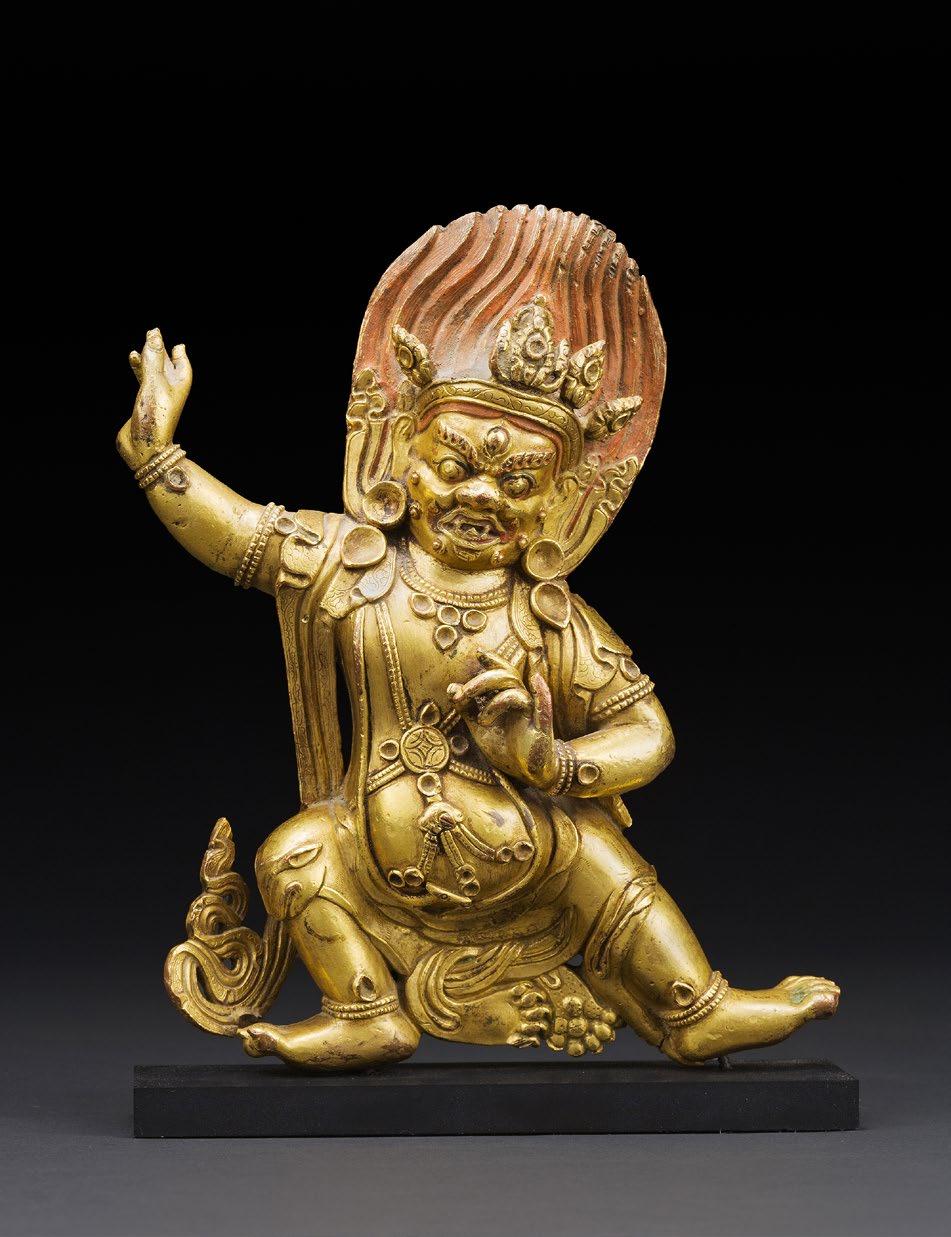
answer the question. After Buddha asked the question one more time he warned Ambatha that his head would be smashed to bits if he failed to answer a third time. In response to the Buddha’s threat, Vajrapani manifested above Buddha’s head, ready to strike Ambatha down with his Vajra (thunderbolt). Upon seeing this Ambatha quickly admitted that what the Buddha spoke was the truth.
The anthropologic origins of Vajrapani can be observed in several instances, two mainly. Mythical roots can be seen stemming to Indra, the thunder god of India, which inherently has deep connections to Zeus, the Greek god of lightning. The depictions of Vajrapani range throughout time, early images of the deity portray him in a much less “wrathful” form, and generally portray him as a powerful and muscle clad male, protecting the Buddha. All three gods can be seen wielding lighting, (Zeus literally, Indra and Vajrapani in the form of a Vajra) and Zeus and Indra both share positions in their respective followings as “King of the Gods”. Besides these more obvious parallels, “Dyaus” is Sanskrit for “sky” and Indra is also known as Indra Dyaus”. “Zeus” is the Greek form of Dyaus. Jupiter is “Dyaus-piter” or “sky father”.
Vajrapani, the bearer of the thunderbolt,
in wrathful form represented in a powerful cast stands in alidasana, the warriors pose, wearing a dhoti incised with tiger-skin stripes flanked by a windswept sash and jewelry adorned around his bountiful midsection, centered with beaded festoons. A thick snake is wrapped around the neck, The wild mane of hair is surmounting Vajrapani’s iconographic third eye. Detailed casting throughout, the face bears a fierce and detailed expression.
T H e F i R s T em P e ROR OF TH e Qi NG dy NA s T y
Unknown, possibly a court artist China
Qing dynasty (1644-1911)
Circa 1900
Ink, colors and gold on silk 24,5 cm (h.) x 23 cm (w.)
Provenance:
Private collection, France
Price on request
Obj EC t Pr ESE nt E d by:
Alan Kennedy
M.: +1 646 753-4938
E.: kennedyalan@hotmail.com
W.: www.alankennedyasianart.com
This portrait represents the first emperor of the Qing dynasty, known by the auspicious name of his reign, Shunzhi. He is depicted from the waist upwards and wears a court hat and a yellow-ground imperial robe (longpao) with a central medallion featuring a five-claw frontal dragon. He is clean shaven and young looking.
The rulers of the Qing dynasty were the Manchus, a nomadic people who originated from beyond the northern borders of China. They represented only one percent of the population of China during their reign.
This imperial portrait is very similar to one of Qing dynasty that is included in an album of Ming and Qing portraits in the collection of the Metropolitan Museum of Art in New York (accession no. 47.81.2, noted as leaf “q” in the Met’s cataloguing). https://www.metmuseum.org/art/collection/ search/49252
A PA i NT i NG OF A V ie W ON TH e W HA m POA PAGO d A i N C ANTON B y s TU di O OF yOUQUA (ACT. 1840-1870)
Hong Kong, China 1860
Enframed in these beautiful Chinese finely craved and laquered wooden frames Price on request
Obj EC t Pr ESE nt E d by: Zebregs&Röell +31 6 207 43671 dickie@zebregsroell.com www.zebregsroell.com
A PORTRA i T OF A COUP le i N l OV e B y s TU di O OF yOUQUA (ACT. 1840-1870)
Hong Kong, China 1860
Enframed in these beautiful Chinese finely craved and laquered wooden frames Price on request
Obj EC t Pr ESE nt E d by: Zebregs&Röell +31 6 207 43671 dickie@zebregsroell.com www.zebregsroell.com






